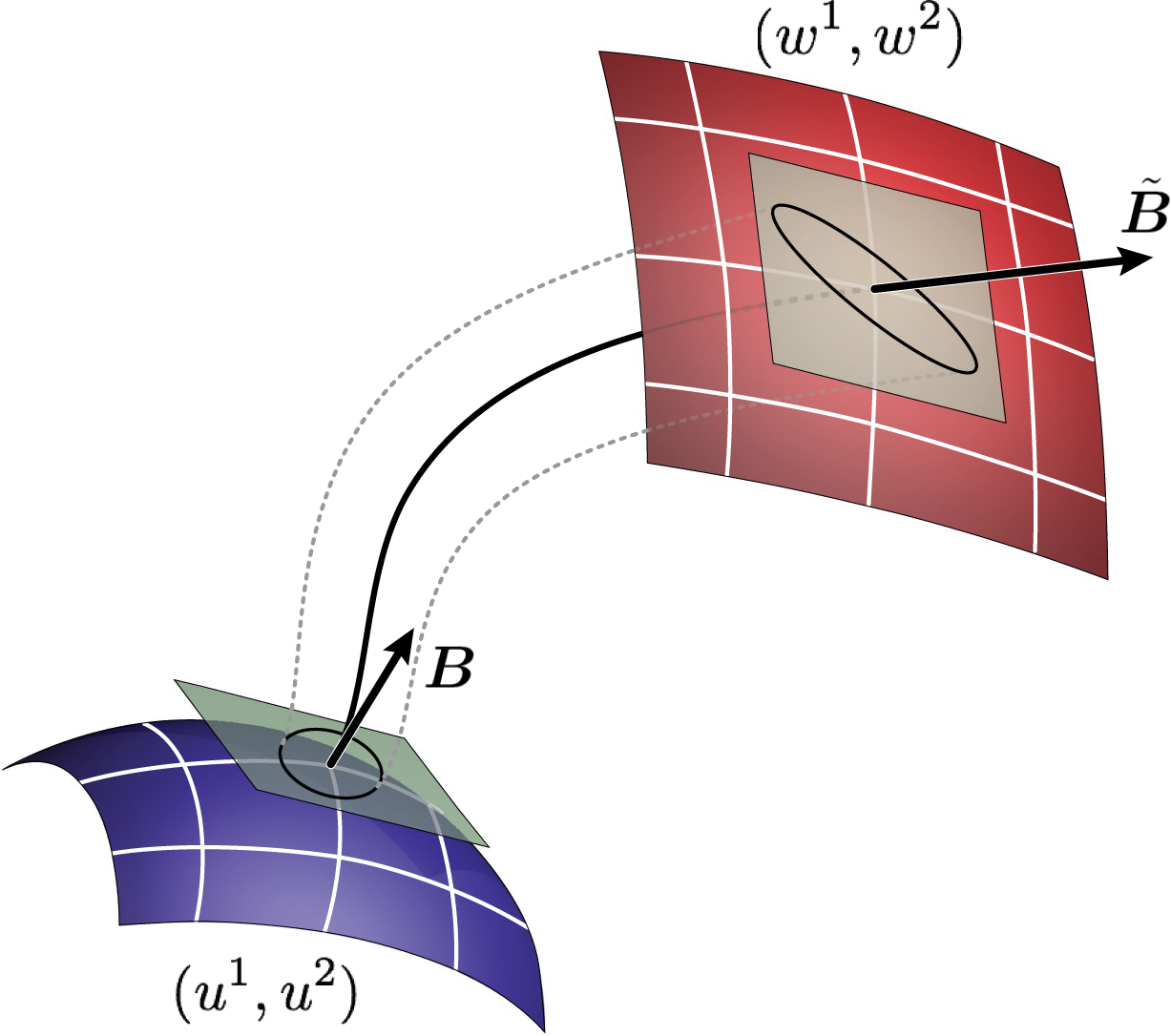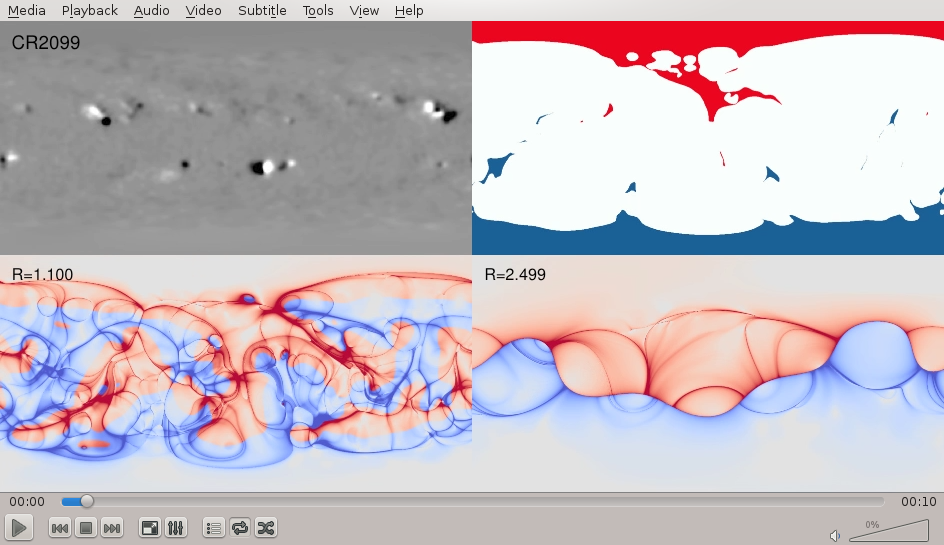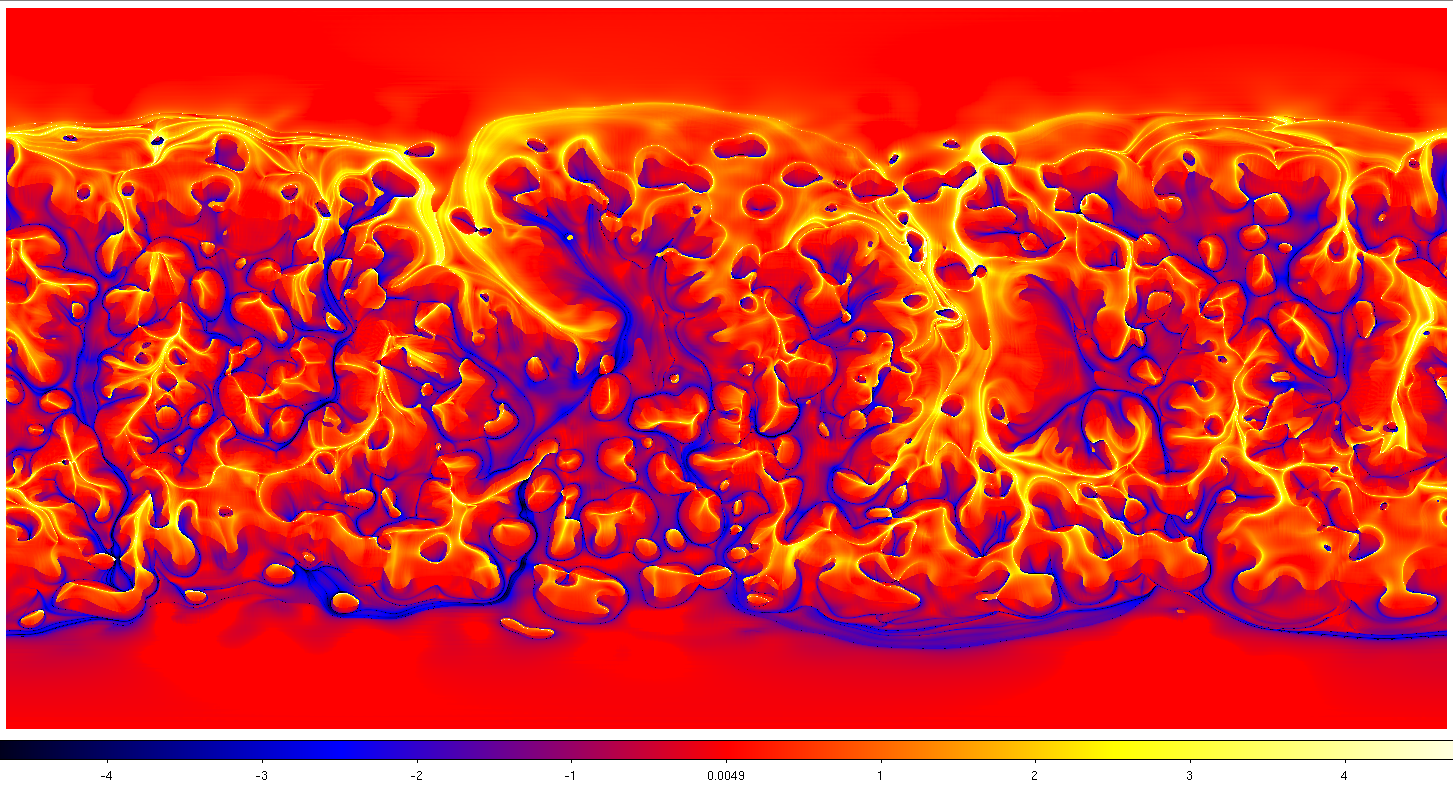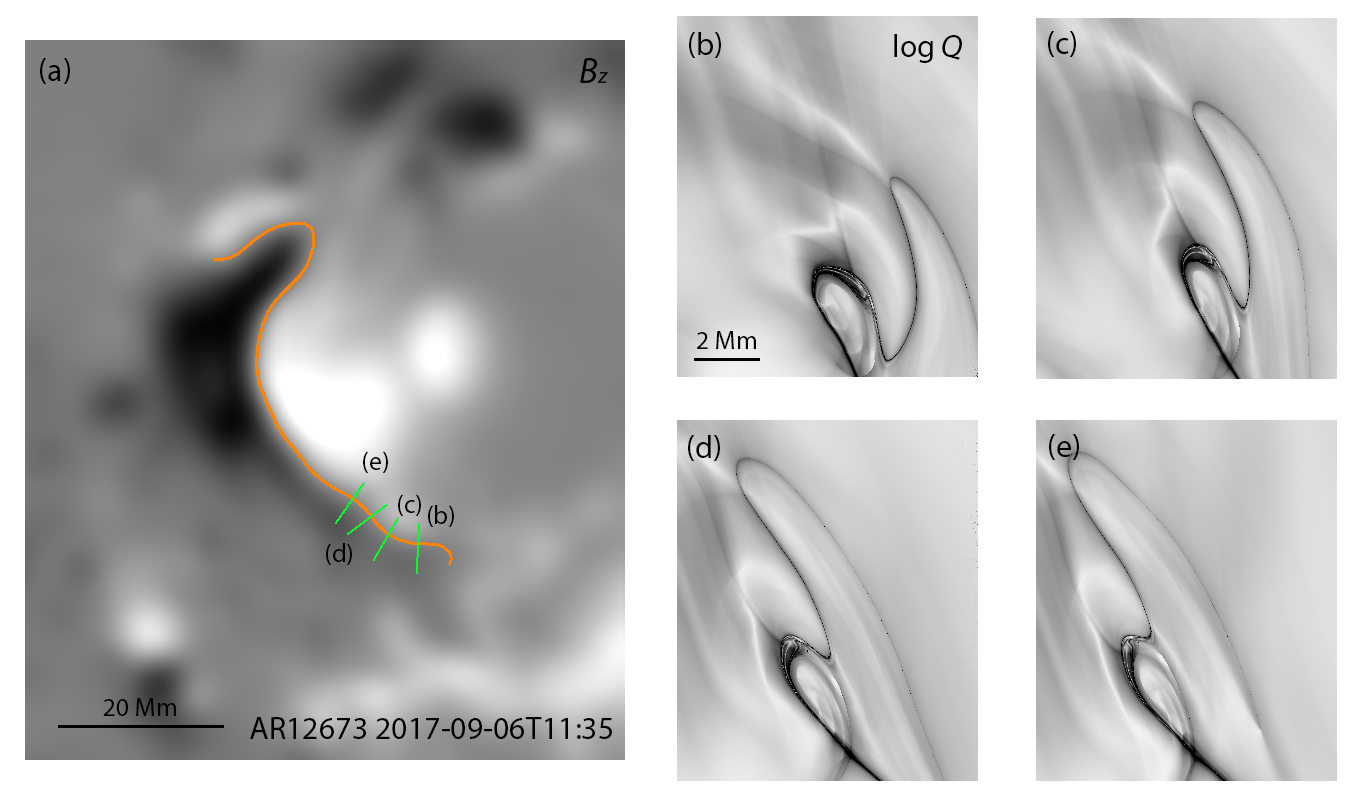Q-Maps -- Insight into the Topology of the Coronal Magnetic Field
The topology of the coronal magnetic field is essential for understanding
solar energetic events and properties of the solar wind. Magnetic null
points, separatrix and quasi-separatrix surfaces are likely preferred sites for
magnetic reconnection. (Quasi-)separatrix surfaces serve as boundaries between
topologically distinct flux systems having different properties.
Knowledge of the magnetic topology of the corona is useful to the solar and
space physics research community, as well as for space-weather forecasting.
It is possible to identify topological regions in the corona where the magnetic
field configuration may be unstable to perturbation. Q, a geometrical parameter
that describes the squashing factor of elemental flux tubes, is useful
for understanding the coronal configurations that are relevant
to space weather. Q-maps provide intuitive visualization of the
topological magnetic features where reconnection may preferably occur. Such
structures are thought to be important for launching the slow solar wind
and have been used to support the
S-Web
theory for the slow wind.
Q-maps are computed from the results of a 3D coronal field model applied to
photospheric magnetic field observations. The general method developed
by Titov et al. (2008,
2011)
is applied to current observations from the HMI (Helioseismic and
Magnetic Imager) instrument on SDO
(Solar Dynamics Observatory) and to archival observations from the
MDI (Michelson Doppler Imager)
instrument on SOHO (the Solar
and Heliospheric Observatory).
What is a Q-Map?
Q characterizes the local divergence of nearby magnetic field lines.
Q is large at separatrix surfaces and quasi-separatix layers.
Closed-field regions of similar field-line connectivity are enclosed by high-Q lines.
Open field regions with different photospheric sources are also separated by
high-Q lines.

| For a given field line, an infinitesimal circle is mapped along
field lines into an infinitesimal ellipse. The circle and ellipse are on
the boundary surfaces of a finite volume defined by curvilinear coordinates
(U1,U2) and (W1,W2) -- for example the photosphere and the source surface of a
coronal field model.
The aspect ratio of the resulting ellipse defines
the squashing factor of the elemental flux tube enclosing the given field line.
Q=N^2/delta where N is the generalized norm and delta is the expansion /
contraction factor (Titov et al, 2008).
When N is large and/or delta is very small, Q can become large.
slog Q is especially convenient for analyzing the structure of magnetic configurations
where
slog Q = sign(Br) * log [Q/2 + (Q^2/4 - 1)^0.5 ] |
We have calculated slog Q at ten heights above the photosphere for each
solar rotation from 1996 to the present.
Q-Map Products Based on Potential Field Source Surface Coronal Field Model
|
The figure shows the photosphere and corona for one complete solar rotation in
August 2010, Carrington Rotation 2099. There are four panels.
The values are computed from HMI observations of the photospheric field.
Each panel is a map of the whole Sun at some height at or above the photosphere.
These figures are frames of a movie.
|
|
|
The upper left panel is the smoothed radial magnetic field in the photosphere
from which the coronal field is calculated. Positive field is white and negative black.
The Sun was not too active in mid 2010.
|

|
Upper right: Foot points near the photosphere that open to the solar wind.
Blue points indicate where the magnetic field polarity is positive (out of the Sun).
Red points have negative polarity.
|
|
|
| Lower left: slog Q map at 1.10 solar radii showing complex structures.
Blue and red show positive and negative polarity. Dark colors are high values of Q.
| Lower right: slog Q at 2.499 Rs showing simplified structure higher
in the corona. The neutral line separating blue and red is the base of the
heliospheric current sheet.
|
HMI Synoptic Products
Synoptic maps of Q are available from the Solar Dynamics Observatory Joint
Science Operations Center (JSOC). JSOC
data series can be exported like any other SDO HMI or AIA data. The primary
data series are described below.
Click on the button to go to the JSOC lookdata program for the indicated data series.
A movie of the synoptic Q-maps, photospheric field, and open-field lines
footpoint can be found in HMI Synoptic Q-Maps
-
The data series hmi.Q_synop has three map segments for each Carrington Rotation
starting with CR 2097 in May 2010.
- slogQ is a 3D data cube containing the signed log Q values at each of
10 heights in the corona.
The latitude-longitude maps have quarter-degree pixels.
- chmap is a single 1441*721 map computed just above the photosphere
(1.001) indicating whether the coronal magnetic field foopoint at the coordinate is
open or closed.
- Brq is another data cube, very much like slogQ, that gives the
radial component of the coronal magnetic field computed using the PFSS model for
each of the 10 heights.
-
The data series hmi.pfss_synop has six data segments for each Carrington Rotation.
- Br, Bt, Bp are the magnetic field components computed at
51 heights in the corona from the photosphere to the source surface at 2.5 Rs.
The radial, theta (southward) and phi (westward) components are in Br, Bt and Bp.
The horizontal resolution of these segments is one degree, thus the data cubes are 361 * 181 * 51
- Brq gives higher resolution (quarter-degree) values of radial field strength at the
10 heights where the Q-Maps are computed.
It is the same as the segment in hmi.Q_synop.
- Br0 is the smoothed one-degree-resolution photospheric map of Br used to make the PFSS calculation.
- gh lists the spherical harmonic coefficients
(g's and h's) computed in the PFSS model up to order 121.
-
The data series hmi.polar_db has, once each year, the best measurement of the high-latitude field
above 60 degrees made during the time of optimal viewing.
The polar field can best be observed when it is most tipped toward Earth.
Due to the inclination of the ecliptic this happens in early March in the south and in September in the north.
The series has four data segments.
- data_raw has the original measurements of the polar field above 60 degrees made during the time
when the pole was most inclined toward Earth. At each pole there are 97 rows equally spaced
in steps of 1/720 in sine latitude and 3600 columns of longitude equally stepped by 0.1 degrees.
- data is a greatly smoothed estimate of the polar field above 60 degrees with the same spatial resolution.
- image_raw is a 600*600 stereographic projection of the original measurements of the polar field above 60 degrees
when the pole was most inclined to Earth.
- image is a 600*600 stereographic projection of the smoothed polar field above 60 degrees when the pole was
most inclined to Earth. A 7th order polynomial smoothing is used.
| hmi.synoptic_mr_polfil_720s
|
|
In order to compute the coronal field, the magnetic field over the entire solar surface must be known,
including the polar regions that are always difficult to observe and often obscured due to Earth's orbit.
Using the method of Sun et al. (2011),
we infer the polar field above 60 degrees from annual observations of the poles when most visible
(See hmi.polar_db above).
The smoothed field is interpolated for earlier years and extrapolated for the most recent months to provide
a good estimate of the large-scale field above 60 degrees for any time interval.
The data series hmi.synoptic_mr_polfil_720s has a single data segment for each Carrington Rotation.
The standard synoptic maps of the radial magnetic field inferred from line-of-sight magnetic
observations taken every 720 seconds are merged with interpolated values of the polar field above 62 degrees.
The field above 75 degrees consists of only the smoothed interpolated values.
- Mr_polfil contains a 3600 * 1440 longitude/sine-latitude map of the full Sun for each Carrington
Rotation that has been adjusted using our best estimate of the polar field.
Recent data for the hidden pole are extrapolated until it is possible to updated with better observations.
MDI Synoptic Products
The Michelson Doppler Imager instrument on SOHO began observing the Sun in 1996 and stopped taking
synoptic magnetic observations in 2011. Data are available for most rotations from CR 1911 -- CR 2107.
The data quality and original resolution are different for MDI than for HMI.
The two instruments overlap from CR 2097 - CR 2107 in 2010 - 2011.
A movie of the MDI synoptic Q-maps, photospheric field, and open-field lines footpoint can be found in
MDI Synoptic Q-Maps.
-
Like the hmi data product, mdi.Q_synop has three data segments for each Carrington Rotation,
the Q-map data cube in slogQ, the foot-point map in chmap,
and the radial field data cube in Brq.
The resolution is the same, and the Q-maps and Br are computed at the same
10 heights in the corona.
-
Like the hmi data product, mdi.pfss_synop has six data segments for each Carrington Rotation:
Br, Bt, Bp are the three components of the coronal field computed using the PFSS model
with one-degree spatial resolution at the 51 heights.
Brq is the higher-resolution radial field data cube at the 10 heights,
Br0 is the smoothed radial field at the photosphere used as input to the PFSS model, and
gh has the harmonic coefficients
of the coronal field between the photosphere and source surface computed up to order 121
using the PFSS model.
-
Like the hmi data product, mdi.polar_db has the best measurement of the polar field above
60 degrees taken during the time interval each year that the pole is best viewed from Earth.
Each pole is measured once per year.
There are four data segments: data_raw and data are the original and smoothed values of
the 97 polemost pixels of the synoptic maps at 3600 longitudes points; image_raw and image
are 600*600 stereoscopic projections of the original and smoothed polar field above 60 degrees.
| mdi.synoptic_mr_polfil_96m
|
|
mdi.synoptic_mr_polfil_96m, like it's hmi counterpart, has a single data segment per Carrington Rotation.
The standard synoptic map is merged, poleward of 62 degrees, with the interpolated, smoothed best-annual
measurement of the polar field. The resolution is the same 3600*1440 longitude/sine-latitude as for HMI.
The radial field is inferred from the MDI 96-minute line-of-sight measurements.
HMI Daily Products
Daily Q-maps are computed using a better measure of the global magnetic field for each particular day.
Standard synoptic maps are observed over a ~27.27-day time span and are assembled using only
central meridian observations as they rotate beneath the Earth. Each longitude is observed
at a different time.
A synoptic frame, used for this product, is constructed for each day using 120 degrees of longitude from
one magnetogram to replace the leftmost edge of the usual synoptic map. At least the left-most third
of the Sun is observed simultaneously on that day.
There are some issues associated with time-evolution and proper motion of magnetic features, but
daily Q-maps can better reflect dynamic conditions as they evolve on the solar surface and
in the corona.

|
|
The colorful figure shows the Q-map for August 25, 2018 at 1.001 Rs.
The map is 360 degrees wide and extends from pole to pole
The left 120 degrees of the input map has been constructed from a magnetogram taken at 12 UT on that day.
The rest of the input frame is the standard synoptic map observed a few to many days earlier at central meridian.
A map is computed each day by extending the map to the left by about 13 degrees.
The color bar for slogQ is at the bottom, with blue (yellow) representing negative (positive) magnetic polarity.
Click on Figure to compare the Q-Maps for 2018 August 25 and 26.
|
Annual movies of daily Q-maps can be found in Yearly Synoptic Frames.
-
Like the other Q_Synop series, hmi.q_synframe has three segments slogQ, chmap,
and Brq, but computed each day with the synchronic frame that includes 120 degrees of data
observed that day.
-
hmi.pfss_synframe has the same contents as the other PFSS data series, but computed each day:
low-resolution Br, Bt, Bp at 51 heights,
daily higher-resolution Brq at 10 heights,
Br0 with the smoothed Br at the photosphere, and gh with the PFSS harmonic coefficients to order 121.
Q-Maps Based on Other Coronal Field Models
Alternative Coronal Models
Q-maps are computed using a data cube of coronal field values,
which can be determined using any model.
Contact the HMI Magnetic Team for information about additional models.
Active Region Q-Maps
We have computed high-resolution Q-Maps above a limited number of active regions
using a non-linear force-free field (NLFFF) model applied to HMI vector magnetic
field measurements. The figure shows results for
a portion of AR 12673 on 6 September 2017 at 11:35 UT.
We may be able to fulfill requests for certain active regions of interest.
Currently the processing runs in IDL and must be tailored for each application.

|
Panel (a) shows the radial component of the photospheric field in a portion of
AR 12673 observed 6 September 2017. The neutral line, in orange, is crossed by four green lines labeled (b) - (e).
The lines are the bottom boundaries of vertical slices of log-Q maps shown in panels (b) - (e).
In this case the field was determined using a Non-Linear Force-Free Field (NLFFF) model.
See Zhao et al, 2014) for model details.
|
These data sets were prepared with support of NASA Grant NNX15AN49G to Stanford University
and was a collaboration between the
Stanford Solar Observatories Group
and Predictive Science, Inc.



